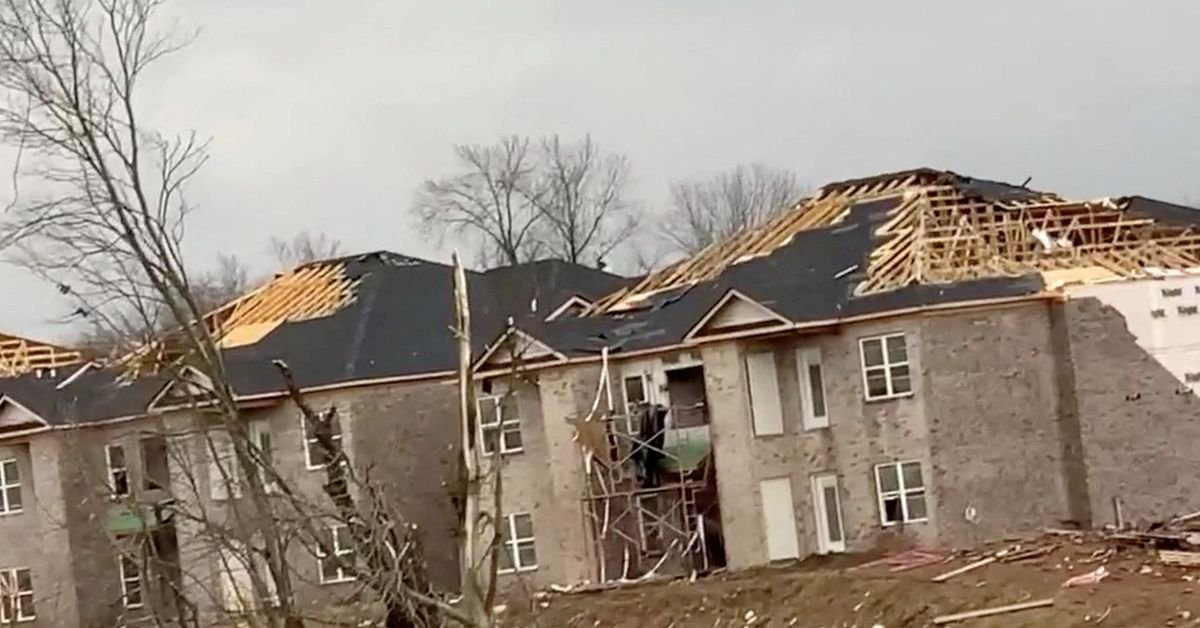U.S. tornadoes push insurers 2021 bill over $105 bln as climate change impact grows – Reuters
Damage is seen after a tornado hit Bowling Green, Kentucky, U.S., December 11, 2021 in this still image taken from a video obtained from social media. Miguel Lopez/via REUTERS
Dec 21 (Reuters) – Devastation from tornadoes that slammed parts of the United States this month will push the insurance industry's 2021 bill for weather-related claims well above the predicted $105 billion, industry experts said, and premiums should rise on worries that climate change will drive more severe weather.
Tornadoes tore a 200-mile path through six states in the Midwest and South, demolishing homes and leveling businesses, causing $5 billion in insured losses, according to preliminary estimates. read more
Climate change has been driving more so-called "secondary peril" weather events that are smaller than hurricanes, for instance, but less predictable. Other secondary perils include small to mid-size localized events like wildfires, winter storms and hail storms.
These events create risk management challenges for insurers and ultimately inflate premiums, said some insurance experts.
"We've got a year of over $100 billion of catastrophe events without having a big named event, whether that's an earthquake or a hurricane," Barnaby Rugge-Price, Chairman of Howden Broking Group, told Reuters.
"Clearly underlying that, something else is going on, of which the most obvious thing is climate change," he said.
On average, there are 1,500 tornadoes per year in the United States, with only 25 occurring in December, according to reinsurance broker Guy Carpenter. This month's cluster of tornadoes was exceptionally rare in terms of the season, the intensity and the length of the storm paths, the company said.
Studies suggest warming Gulf of Mexico surface temperatures are linked to intense thunderstorm updrafts that can generate tornadoes in the U.S. Southeast's Dixie Alley, said catastrophe modeling firm Karen Clark & Company (KCC).
Warmer air in late autumn and early winter create favorable conditions for producing tornadoes, which could elongate the severe weather season over North America, said the reinsurer Guy Carpenter & Co LLC.
Unlike primary perils like hurricanes, which have the highest potential for losses and are therefore closely monitored and modeled, secondary perils are unpredictable.
They are harder to model due to insufficient data, Rugge-Price said, making it in turn more difficult for the industry to assess the risks.
"Hurricanes have been recorded, and we know the path and we know the damage, whereas tornadoes, they just…pop up," he added.
Some experts said it is not easy to draw a clear connection between climate change and the rising severity of tornadoes. KCC said tornadoes form in specific atmospheric conditions and it could be "challenging to attribute specific trends in severe weather to climate change".
Still, this year has seen a rise in the severity of such secondary perils.
Before the tornadoes hit, the global insurance industry was facing an estimated $105 billion in losses this year, the fourth-highest on record, without a single giant weather catastrophe, according to reinsurance giant Swiss Re. read more
While Hurricane Ida was the single costliest natural disaster in 2021, more than half the losses were related to secondary peril events including winter storm Uri that brought freezing temperatures to Texas.
At least one severe annual secondary peril event is the new “norm," each resulting in more than $10 billion in losses, Swiss Re (SRENH.S) said.
"Natural catastrophe losses are likely to continue growing given increases in wealth, urbanization and the effects of climate change," the company said.
PROPERTY PREMIUMS
Insurance industry sources said more severe events have boosted U.S. property insurance prices for the past four years. Clients with significant exposure to secondary perils experienced above-average rate increases in the third quarter, Swiss Re said.
Insurance premiums are likely to continue rising, brokers said, and property owners seeking insurance also must shoulder higher retentions, initial costs they must bear themselves before insurance kicks in.
"We don't expect to see a reduction in capacity available for tornado coverage," said Dave Reasons, Marsh's U.S. Central Zone Property Leader. However, he said, some clients were willing to bear retentions tenfold higher than in the past to keep premiums low.
"We certainly may see discussions about the right retentions, the right pricing for that."
Our Standards: The Thomson Reuters Trust Principles.
Subscribe for our daily curated newsletter to receive the latest exclusive Reuters coverage delivered to your inbox.
Reuters, the news and media division of Thomson Reuters, is the world’s largest multimedia news provider, reaching billions of people worldwide every day. Reuters provides business, financial, national and international news to professionals via desktop terminals, the world's media organizations, industry events and directly to consumers.
Build the strongest argument relying on authoritative content, attorney-editor expertise, and industry defining technology.
The most comprehensive solution to manage all your complex and ever-expanding tax and compliance needs.
The industry leader for online information for tax, accounting and finance professionals.
Access unmatched financial data, news and content in a highly-customised workflow experience on desktop, web and mobile.
Browse an unrivalled portfolio of real-time and historical market data and insights from worldwide sources and experts.
Screen for heightened risk individual and entities globally to help uncover hidden risks in business relationships and human networks.
All quotes delayed a minimum of 15 minutes. See here for a complete list of exchanges and delays.
© 2021 Reuters. All rights reserved




